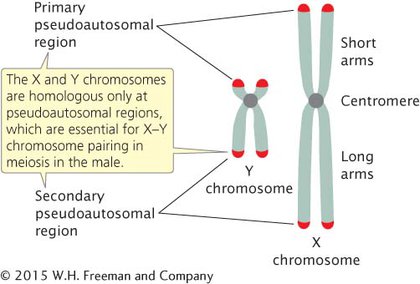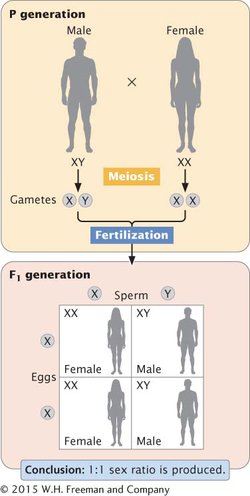Chromosomal Sex-Determining Systems
Sex in many organisms is determined by a pair of chromosomes, the sex chromosomes, which differ between males and females. The nonsex chromosomes, which are the same for males and females, are called autosomes. We think of sex in these organisms as being determined by the presence of the sex chromosomes, but in fact, the individual genes located on the sex chromosomes are usually responsible for the sexual phenotypes.
XX-XO SEX DETERMINATION In some insects, sex is determined by the XX-XO system. In this system, females have two X chromosomes (XX), and males possess a single X chromosome (XO). There is no O chromosome—the letter O signifies the absence of a sex chromosome.
In meiosis in females, the two X chromosomes pair and then separate, with one X chromosome entering each haploid egg. In males, the single X chromosome segregates in meiosis to half the sperm cells; the other half receive no sex chromosome. Because males produce two different types of gametes with respect to the sex chromosomes, they are said to be the heterogametic sex. Females, which produce gametes that are all the same with respect to the sex chromosomes, are the homogametic sex. In the XX-XO system, the sex of an individual is therefore determined by which type of male gamete fertilizes the egg. X-bearing sperm unite with X-bearing eggs to produce XX zygotes, which develop into females. Sperm lacking an X chromosome unite with X-bearing eggs to produce XO zygotes, which develop into males.
XX-XY SEX DETERMINATION In many species, the cells of males and females have the same number of chromosomes, but the cells of females have two X chromosomes (XX) and the cells of males have a single X chromosome and a smaller sex chromosome called the Y chromosome (XY). In humans and many other organisms, the Y chromosome is acrocentric (Figure 4.4)—not Y-shaped, as is often assumed. In this sex-determining system, males are the heterogametic sex—half of the gametes produced by a male have an X chromosome and half have a Y chromosome. Females are the homogametic sex—all the egg cells produced by a female contain a single X chromosome. A sperm containing a Y chromosome unites with an X-bearing egg to produce an XY male, whereas a sperm containing an X chromosome unites with an X-bearing egg to produce an XX female, which accounts for the 50 : 50 sex ratio observed in most organisms (Figure 4.5). Many organisms, including some plants, insects, reptiles, and mammals (including humans), have the XX-XY sex-determining system. Other organisms have odd variations of the XX-XY system of sex determination, including the duck-billed platypus, in which females have five pairs of X chromosomes and males have five pairs of X and Y chromosomes.

4.4 The X and Y chromosomes in humans differ in size and genetic content. They are homologous only at the pseudoautosomal regions.

4.5 The inheritance of sex in organisms with X and Y chromosomes results in equal numbers of male and female offspring.
Page 78
Although the X and Y chromosomes are not generally homologous, they do pair and segregate into different cells in meiosis. They can pair because these chromosomes are homologous at small regions called the pseudoautosomal regions (see Figure 4.4), in which they carry the same genes. In humans, there are pseudoautosomal regions at both tips of the X and Y chromosomes.
ZZ-ZW SEX DETERMINATION In ZZ-ZW sex determination, females are heterogametic and males are homogametic. To prevent confusion with the XX-XY system, the sex chromosomes in this system are labeled Z and W, but the chromosomes do not resemble Zs and Ws. Females in this system are ZW; after meiosis, half of the eggs have a Z chromosome and the other half have a W chromosome. Males are ZZ; all sperm contain a single Z chromosome. The ZZ-ZW system is found in birds, snakes, butterflies, some amphibians, and some fishes.
CONCEPTS
In XX-XO sex determination, the male is XO and heterogametic, and the female is XX and homogametic. In XX-XY sex determination, the male is XY and the female is XX; in this system, the male is heterogametic. In ZZ-ZW sex determination, the female is ZW and the male is ZZ; in this system, females are the heterogametic sex.

